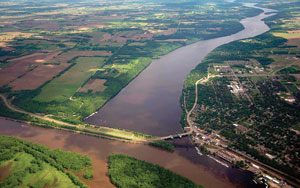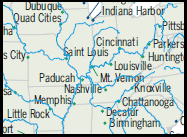CQ WEEKLY – IN FOCUS
Oct. 20, 2012 – 1:05 p.m.
Keeping the Water Bill Afloat Without Earmarks
By Nathan Hurst, CQ Staff
Senate Environment and Public Works Chairwoman
That would be hard enough in the best of circumstances. It took Congress seven long years of negotiations to produce the last law authorizing flood-control, navigation and environmental restoration projects in 2007 — and even that was accomplished only after lawmakers secured hundreds of earmarks.

|
||
|
Since then, Congress has sworn off earmarks, which only makes the task more difficult. Because previous water resources bills were essentially laundry lists of lawmaker-designated projects, producing one now will force Congress to face the dilemma of abandoning — or at least redefining — its earmark moratorium. That, or it has to devise a radically new framework to pay for waterway improvements.
Boxer says she has created a formula that would spell out the criteria that the Army Corps of Engineers would consider in selecting water projects to be carried out. House authorizers are dubious about that approach and are quietly urging their leaders to revisit the earmark ban, according to lobbyists and legislative aides.
“We’re having those discussions about what is an earmark and whether it really makes sense to leave project selection up to bureaucrats,” a House aide says.
For her part, Boxer calls the earmark ban “ridiculous” — even as she tries to adapt to it.
“I think as a result of that, you have the administration with all the power, whether it’s this one or a Romney one or a Bush one,” she said at a committee hearing last month. “I believe it’s our job.”
Without earmarks, Boxer says she will establish “standards for projects,” although lobbyists following the issue say the plan is to sidestep the earmark ban by issuing a committee report to accompany the legislation that would identify specific projects meeting those new standards.
Boxer has promised a markup before the end of the year, underscoring the sense of urgency among Senate authorizers who want a bargaining chip for post-election negotiations on the deficit and tax-reduction. The aim is to have legislative language ready in case there is an opportunity to attach it to a broader tax overhaul or deficit reduction deal that might emerge at the end of this year or early in the next Congress. “We see that as a positive,” says David B. Sanford II, director of navigation policy and legislation at the American Association of Port Authorities. “If you get to a full committee markup on a bill before the end of the year, that’s huge. It tees the issue up nicely for immediate action next year.”
Revisiting Earmarks
Even the 2007 Water Resources Development Act, with 93 pages authorizing more than 800 lawmaker-designated projects and studies, would not have run afoul of a ban on earmarks as they were long understood. The term “earmark” was commonly used to describe specific expenditures on projects selected by individual lawmakers. While previous water bills identified the projects eligible for funding, it was still up to appropriators to provide the money.

|
||
|
Keeping the Water Bill Afloat Without Earmarks
But the earmark ban that House Republicans put in place upon taking control in the 112th Congress went beyond appropriations to include provisions or committee reports “authorizing” specific activities.
House Republicans are beginning to see that such a broad definition of an earmark ties their hands, particularly in trying to write ambitious authorizing legislation like a water bill.
A lobbyist in close contact with party leaders on the issue says there is a “widespread feeling on the House side” that a water bill needs to get done, “but a lot of concern about how you get an effective one done without naming the projects folks need.”
Lobbyists and House aides say Speaker
Even some congressional champions of earmark restrictions have been open to considering an exception for spending on transportation infrastructure — and especially water projects. For example, Sen.
Senators are already lining up to make sure water projects important to their states are not left out of the next water resources bill.
This month, for example, California’s other Democrat senator,
And last month, a bipartisan group of six Midwestern senators led by Majority Whip
Looking After Home
Other senators promoted their wish lists at the committee hearing last month. Maryland Democrat
“I trust the senators and members of Congress who know the ground on which they live to make these decisions,” she said. “That’s the reason it’s frustrating to all of us.”
Beyond parochial interests, authorizers see a potential opportunity in the debt-reduction talks to address concerns about the fund that pays for harbor maintenance and dredging.
The Harbor Maintenance Trust Fund, which is supported by a tax of $1.25 per $1,000 on imported and domestic cargo, has a surplus that exceeds $7 billion. But expenditures are set by appropriators and subject to Army Corps of Engineers budget ceilings, and shippers complain that much of the user fees they contribute are not being spent.
Keeping the Water Bill Afloat Without Earmarks
“Port and harbor users are paying for 100 percent of maintenance dredging and getting half in return,” Henry Bridges, chairman of the American Association of Port Authorities, told Boxer’s committee last month.
Bills introduced in both chambers would require all the money contributed to the fund each year to be spent on harbor maintenance and dredging. Efforts to attach the legislation to the surface transportation authorization enacted this summer were rejected in conference, in part because budget rules would require the spending to be offset.
Republican Sens.
The amendment also is expected to include a version of House legislation to boost funding for inland and intracoastal waterways. A bill by Kentucky Republican Rep.
Supporters hope these issues can be addressed in any deficit reduction deal that might emerge after the election to avoid automatic spending cuts and tax increases.
“If there’s already momentum building toward fixing a lot of other issues, we want to be part of that,” says Michael Toohey, president and chief executive of the Virginia-based Waterways Council.
John D. Boyd contributed to this story.
FOR FURTHER READING:
Harbor maintenance funding, CQ Weekly, p. 1252; 2007 Water Resources Development Act (PL 110-114), 2007 Almanac, p. 18-3. Harbor Maintenance Trust Fund bills are